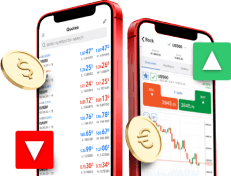The U.S. dollar is trying to stabilize after yesterday's repricing, when it lost about 0.5 percent against major currencies during the previous session due to weak U.S. GDP data.
The US economy grew at its slowest pace in more than a year, reinforcing speculation that other central banks may raise interest rates faster than the Federal Reserve. Meanwhile, the euro gained sharply against the dollar on Thursday after Christine Lagarde failed to convince markets that the European Central Bank would remain dovish in the face of elevated inflation levels. According to interest rate market participants, the ECB may raise the cost of borrowing by 20 basis points in October 2022, where earlier pricing had assumed a hike in December 2022. Moreover, long-term inflation expectations were above 2 percent, which shows that the market does not believe in the transitory nature of price increases, as central banks have been trying to convince us for a long time.
Investors are now awaiting the meeting of the US central bank next week. It may allow us to assess the direction of monetary policy, as the Fed is balancing on the verge of slowing economic growth and rising inflation, i.e. transition to stagflation. This may also be indicated by the inversion of the yield curve at the long end, where interest rates on 20-year US bonds were higher than on 30-year bonds for the first time.
Long squeeze - what is it?
In the markets, you often hear about the phenomenon of a short squeeze. It means "throwing out" market participants from short positions, i.e. those, which were betting on the decline of the value of the given underlying market. In contrast, long squeeze is the rapid closing of positions that were opened on the basis of an increase in the value of the underlying asset.
If we look at positioning on U.S. dollar futures, we can see that non-commercial investors (speculators) have the most long positions since October 2019, according to CFTC data. These may be leveraged positions that require margin to hold. If the value of the dollar against other currencies were to fall and investors did not have the funds to top up their margins, that is when the long squeeze could occur and faith in a strong USD could collapse.
Perhaps after the Fed decision in early November, everything will become clearer as to who is right in terms of the potential strength of the USD.
Daniel Kostecki, Director of the Polish branch of Conotoxia Ltd. (Forex service)
Materials, analysis and opinions contained, referenced or provided herein are intended solely for informational and educational purposes. Personal opinion of the author does not represent and should not be constructed as a statement or an investment advice made by Conotoxia Ltd. All indiscriminate reliance on illustrative or informational materials may lead to losses. Past performance is not a reliable indicator of future results.
CFDs are complex instruments and come with a high risk of losing money rapidly due to leverage. 78% of retail investor accounts lose money when trading CFDs with this provider. You should consider whether you understand how CFDs work and whether you can afford to take the high risk of losing your money.


